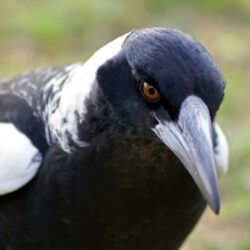Another bird of Australia with a much-loved character and a beautiful distinctive song. They can be aggressive if they feel encroached and there are so many stories, especially around school drop-offs and pickups, of maggies SWOOPING visitors to defend their territory. They are monogamous in relationships and defend nests together. In this mode, they can cause some damage. We learn early to be wary of them when it is mating season and they are protecting a nest.
They have no fear – are not at all shy – like your friend that walks in and helps themselves to whatever is in the fridge – love that. I have 2 of them in my backyard that love hanging nearby as I mow the lawn, excited to catch disorientated worms that come to the surface. They eat most insects – spiders, moths, caterpillars, snails, millipedes, scorpions, beetles – you get the idea. They’re great at keeping insect populations in check. There are usually a couple of willy wagtails hanging around as well, but maggies have such a presence and we do think of them as friends. I talk to them. Their song is called ‘caroling’ or ‘warbling’ and can be heard a great distance away.
As a group, they are most commonly known as a TIDING of magpies. They can also be referred to as a gulp, conventicle, mischief, or tittering of magpies. My favorite is a “mischief of magpies” though a “tiding of magpies” is more common. They’re good-natured as a general rule and even play with our other pets like cats and dogs, especially if they’ve grown up together.
They’re 37-43cm in length and have a wing span of 65-85cm, and weigh 220-350g. Life span is 25-30 years. Magpies are entrenched in the Australian story.

